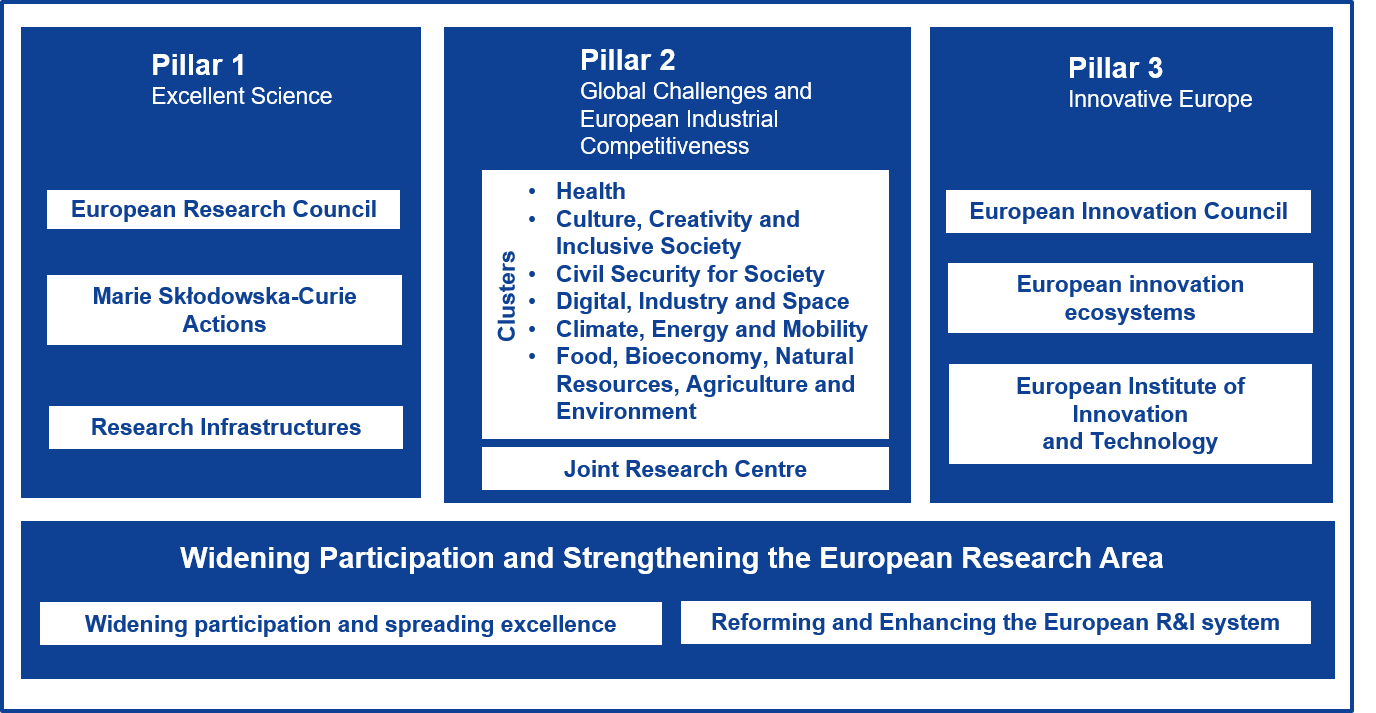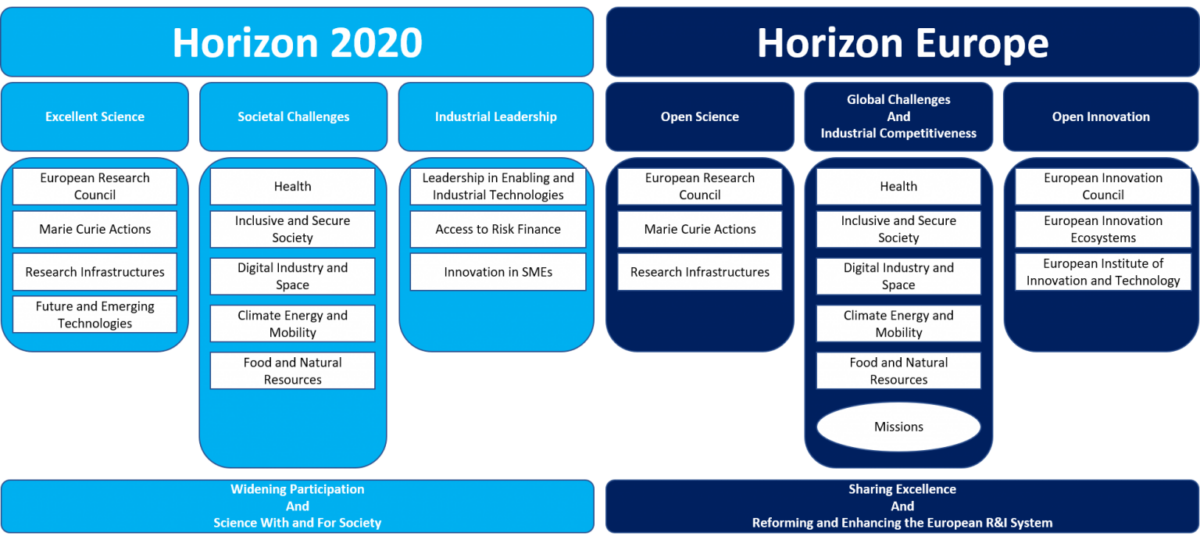The European Union (EU) has a long-standing tradition of funding research and innovation through multi-annual framework programs. Among these, Horizon 2020 and Horizon Europe stand out as flagship initiatives. Both aim to boost Europe’s scientific and technological competitiveness while addressing societal challenges and fostering a sustainable future. In this article, we’ll dive into a comparative analysis of Horizon 2020 and Horizon Europe, highlighting their objectives, structures, and key differences.
Introduction: A Brief Overview
Horizon 2020 (H2020): Spanning from 2014 to 2020, Horizon 2020 was the EU’s eighth framework programme with a budget of approximately €80 billion. It sought to drive economic growth and job creation by coupling research with innovation and focusing on excellent science, industrial leadership, and tackling societal challenges. Horizon 2020 was one of the world’s most substantial programmes dedicated to research and innovation. Its aim was to ensure that Europe produces world-class science, removes barriers to innovation, and makes it easier for the public and private sectors to work together in delivering solutions to big challenges facing society.
Key Objectives of Horizon 2020:
- Promote Excellence in Science: Support top-tier research in Europe.
- Foster Industrial Leadership: Boost the EU’s global competitiveness.
- Address Societal Challenges: Tackle major issues common to all Europeans.
Horizon Europe: Succeeding H2020, Horizon Europe runs from 2021 to 2027 with an ambitious budget of around €95.5 billion. While it builds on the achievements of its predecessor, Horizon Europe introduces new elements to further amplify the EU’s research and innovation capacities.
Objectives of Horizon Europe:
- Promote Excellence: Boost the quality and impact of European research and innovation to achieve scientific leadership globally.
- Tackle Global Challenges: Address the significant societal challenges faced by Europe and the world, such as climate change, demographic shifts, and global pandemics.
- Stimulate Economic Growth: Enhance Europe’s innovation capacity, competitiveness, and job creation.
Structure and Pillars
Horizon 2020:
- Excellent Science: Funding for frontier research through the European Research Council (ERC), Marie Skłodowska-Curie Actions, and Future and Emerging Technologies.
- Industrial Leadership: Investment in key industrial technologies, access to risk finance, and support for innovative SMEs.
- Societal Challenges: Addressing challenges like health, clean energy, and transport through collaborative research.
Horizon Europe:
- Excellent Science: Continuation of the ERC, Marie Skłodowska-Curie Actions, and infrastructural support.
- Global Challenges and European Industrial Competitiveness: Combines aspects of H2020’s Industrial Leadership and Societal Challenges, emphasizing thematic clusters like health, culture, and mobility.
- Innovative Europe: Introduces the European Innovation Council (EIC) and supports the expansion of the European innovation ecosystem.
- Widening Participation and Strengthening the European Research Area: Focuses on broadening participation and investing in R&I capacities across the continent.
Key Innovations in Horizon Europe
While Horizon Europe builds upon the foundations set by H2020, it introduces several innovations:
- European Innovation Council (EIC): A significant new initiative, the EIC serves as a one-stop shop to bring the most promising high-potential and breakthrough technologies from the lab to real-world application and support start-ups and SMEs to scale up.
It blends both grants and equity investments, providing a holistic approach to funding. - Missions: Horizon Europe introduces mission-oriented research, where specific missions with clear, measurable goals are set to address urgent societal challenges.
Examples include fighting cancer, adapting to climate change, and ensuring healthy oceans. Each mission is a commitment to solve a pressing challenge in society within a set timeframe. - New Approach to Partnerships: Horizon Europe aims to rationalize the partnership landscape by establishing fewer but more impactful EU co-funded partnerships and co-programmed partnerships with Member States, industry, and other stakeholders.
The goal is to increase effectiveness, ensure alignment with policy priorities, and reduce administrative burdens. - Strengthened International Cooperation: While Horizon 2020 emphasized international collaboration, Horizon Europe takes it a step further by promoting research and innovation partnerships with non-EU countries.
This aims to strengthen the EU’s scientific and innovation prowess globally and tackle global challenges more effectively. - Enhanced Focus on Widening Participation: Horizon Europe introduces measures to support the “widening countries” – EU Member States and Associated Countries that have been relatively underrepresented in previous Framework Programmes.
The goal is to reduce the R&I divide among European countries and promote excellence everywhere. - R&I Days: Horizon Europe introduced the concept of “Research and Innovation Days” as an annual event to debate and shape the future of research and innovation in Europe.
- Simpler and More Streamlined Implementation: Building on the experiences of Horizon 2020, Horizon Europe emphasizes a more straightforward and user-friendly implementation of its processes, making it easier for applicants and beneficiaries.
This includes a more intuitive submission system, clearer rules, and reduced administrative requirements. - Open Science: Horizon Europe has a reinforced commitment to open science practices, ensuring public access to publicly funded research data and publications.
This further promotes transparency, collaboration, and the acceleration of research through shared resources.
Budget Allocation

The budget increase from H2020 to Horizon Europe mirrors the EU’s commitment to remaining at the forefront of global research and innovation. Horizon Europe’s budget is more strategically distributed among its pillars, with increased emphasis on innovation through the EIC and a focus on widening participation.
Here’s a breakdown of the budget allocation for Horizon Europe:
1. Three Main Pillars:
Excellent Science (~€25.8 billion):
- European Research Council (ERC): €16.6 billion
- Marie Skłodowska-Curie Actions: €6.8 billion
- Research Infrastructures: €2.4 billion
Global Challenges and European Industrial Competitiveness (~€52.7 billion):
- Health: €7.7 billion
- Culture, Creativity, and Inclusive Society: €2.2 billion
- Civil Security for Society: €2.8 billion
- Digital, Industry, and Space: €14.7 billion
- Climate, Energy, and Mobility: €15 billion
- Food, Bioeconomy, Natural Resources, Agriculture, and Environment: €10.3 billion
Innovative Europe (~€10.1 billion):
- European Innovation Council (EIC): €10 billion
- European Innovation Ecosystems: €0.5 billion
- European Institute of Innovation & Technology (EIT): €3 billion
2. Widening Participation and Strengthening the European Research Area (~€3.3 billion):
- This budget allocation is aimed at reducing the R&I divide among European countries and ensuring that all member states can participate effectively in the program.
3. Nuclear Safety and Security (~€1.4 billion):
- This budget is set aside for research and training in nuclear safety and security.
4. Other Programs and Actions:
- Certain amounts are allocated to specific initiatives, pilot projects, and preparatory actions. The exact budget for these can vary based on the evolving needs and priorities of the EU.
Both Horizon 2020 and Horizon Europe represent the EU’s ambitious strides towards a future fueled by research and innovation. While H2020 laid a robust groundwork for R&I in Europe, Horizon Europe takes it a notch higher, aiming for more inclusivity, market-driven innovations, and a mission-oriented approach. As we progress further into the Horizon Europe era, it will be exciting to witness the transformative changes it brings to the European scientific and industrial landscape.
